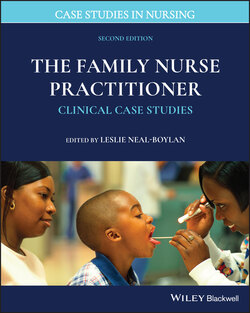Читать книгу The Family Nurse Practitioner - Группа авторов - Страница 61
ОглавлениеCase 6.8 Abdominal Pain
By Leslie Neal‐Boylan, PhD, APRN, CRRN, FAAN, FARN
SUBJECTIVE
Rachel is a 17‐year‐old Caucasian female who presents with complaints of decreased appetite, fatigue, nausea, and intermittent abdominal pain for the past 2–3 weeks. She describes the abdominal pain as sharp and focused in the right epigastric area. She also reports some new‐onset pain in her right shoulder but attributes this to carrying around her baby more than usual. She denies vomiting, diarrhea, or constipation. Her typical diet consists of pizza, hot dogs, and salads. Rachel denies any association of her symptoms with food or hunger. Her last normal menstrual period was 3 weeks ago, and she has had 2 negative pregnancy tests at home.
Past medical history: She delivered her son 6 months ago vaginally without complications. Her only other medical history includes a kidney infection 4 months ago.
Social history: She smokes 7 cigarettes a day but admits, “I really don’t need them. I am bored.” Rachel lives with her boyfriend (the father of her child) and his parents. She moved in, far away from her home, only recently. Her parents made her leave their house when she told them she was pregnant, and they have no contact with her. She states that she feels safe at home and is enjoying her baby. Her boyfriend helps with the baby but often goes out at night with his friends and leaves her at home with the baby. She feels a little isolated because everyone works during the day and she has no access to transportation. She is dependent on her in‐laws if she needs to go anywhere by car, and they do not often support her need to go anywhere. Otherwise, she walks. She walked here today for her appointment.
Medication: She is not allergic to any medication and only takes birth control pills.
OBJECTIVE
Vital signs: Rachel is afebrile. BP is 120/80. Pulse is 68 and regular.
Eyes: PERRLA. EOMs are intact. Optic disks are sharp.
Cardiac: Cardiac exam reveals regular rate and rhythm.
Respiratory: Respirations are 12, steady, and unlabored. Lungs are clear.
Abdomen: Soft with mild tenderness to palpation (TTP) in the RUQ with a positive Murphy’s sign. There is no CVA tenderness.
Genitourinary: A urine dipstick reveals positive protein. A urine HCG is negative.
Rachel is diagnosed at this first visit with possible cholecystitis and is given Antivert 12.5 mg for her nausea.
Blood is drawn and sent to the lab. Her urine is sent for analysis, and she is told to return in 1 week.
Rachel returns 1 week later. Her bloodwork reveals a blood glucose of 45 mg/dL. Her other bloodwork is within normal limits. Her urinalysis returns with few bacteria and no protein. Rachel reports that the abdominal pain has worsened and she now has headaches. She denies a history of migraines or frequent headaches. Her nausea is still present but decreased.
Her exam remains unchanged.
CRITICAL THINKING
1 What is the most likely differential diagnosis in this case and why?__Cholelithiasis__Gastroenteritis__Diverticulitis__Insulin tumor__Gastric tumor__Cholecystitis
2 Which diagnostic tests are required in this case and why?__Abdominal ultrasound__Abdominal CT scan__Head CT scan__KUB X‐ray__CBC__Metabolic panel__LFTs__Insulin level__C‐peptide__OGGT__Gastrin level
3 What is the plan of treatment?
4 Are any referrals needed?
5 Does the patient’s home situation influence the plan?
6 Are there any standardized guidelines that should be used to treat this case?
